A Postcard From 3 Billion Years Ago
Antarctic Lake Serves as a Rare Modern Analog to Ancient Ecosystems
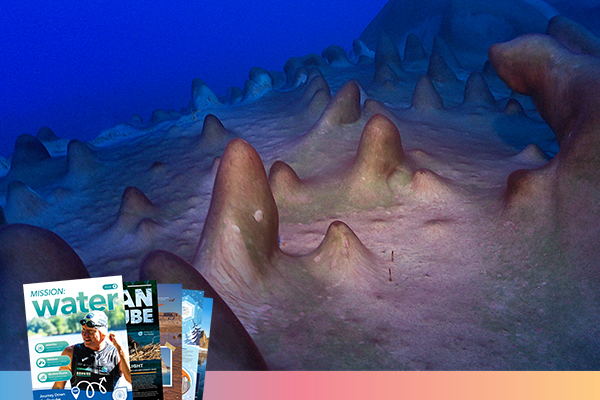
These one-to-two-foot-high cones have been formed over eons, layer by sub-millimeter layer, by a cyanobacterial genus called Phormidium. While they have been observed as deep as 100 meters, the lake remains largely unexplored between 100 meters and its deepest point (170 meters).
Slipping under three plus meters of ice into the cold water of Lake Untersee, Dale Andersen enters a world cut off from the rest of Antarctica and removed from the modern era. The water is super-saturated with oxygen, its pH is around 10.4, and the largest creatures in the lake are tardigrades, transparent "water bears" less than a millimeter in length.
As Andersen descends with his tether to study the lake's bottom, its real uniqueness shows—countless conical stromatolites like a vast parking lot full of traffic cones. The one-to-two-foot-high cones have been formed over eons, layer by sub-millimeter layer, by a consortium of cyanobacterial species dominated by a genus called Phormidium.
Skinny, finger-sized pinnacles are a familiar feature of many other Antarctic lakes, and they occur in Lake Untersee, too. But until Andersen and his colleagues described the stromatolites in a 2011 paper, the “large, conical stromatolites” had never been found in a modern environment. Many geologists would recognize that they are almost identical to the fossilized mounds of the Strelly Pool formation in Australia...but those are traces of the dawn of life on Earth, when all the planet's occupants were microbes.
"This is like a postcard from 3 billion years ago," Andersen says. “If you wanted to visualize what an ecosystem looked like during those times, these Antarctic lakes provide wonderful analogs of those early microbial landscapes.”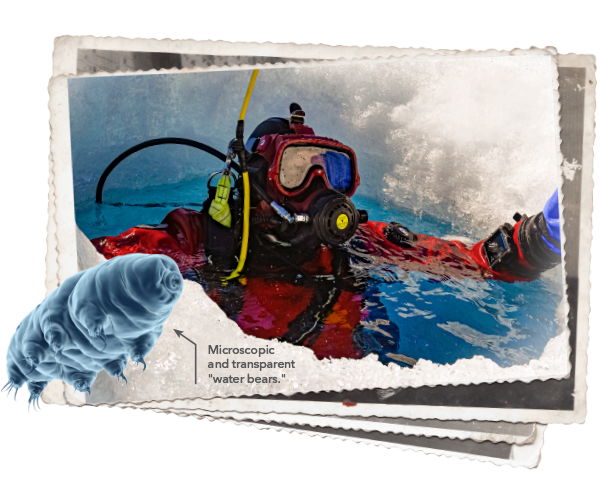
Slipping under three meters of ice into the cold water of Lake Untersee, Dale Andersen enters a world cut off from the rest of Antarctica.
A key element is that the microbes are nearly alone in Lake Untersee. The only other life are tardigrades (celebrated among biologists for being able to survive extreme conditions from freezing water to boiling hot springs), microscopic rotifers, and nematodes. There are no insects, fish, or plants to interfere with the microbes' architecture or damage the delicate cones, pinnacles, and mats they build.
"In modern environments, we have so many animals and plants and things that are disrupting the local environments that the microorganisms are unable to build the structures they did billions and billions of years ago," he explains.
"That's the nice thing that we see here. We've got a nice, modern analog to those ancient ecosystems."
Andersen has been diving in Lake Untersee for more than a decade, and remains in awe of the unique vision of its landscape of cones. In fact, he notes, "more people have walked on the surface of the moon than have seen, in-person, the bottom of this lake."
Inner and Outer Space
There's a little irony in Andersen drawing a parallel between space exploration and his work in Antarctica.
The upstate New York-based geobiologist bridges the two frontiers through research endeavors he carries out as a senior scientist within the Carl Sagan Center of the SETI Institute.
“Understanding those early paleoenvironments or early biospheres on our own planet is an important aspect of understanding how one goes about the search for life elsewhere,” Andersen notes. “NASA’s exobiology program is geared towards understanding the origins, evolution, and distribution of life in the universe. That includes understanding how life formed on our own planet, the evolutionary history of life on this planet, and how it was shaped by planetary events over the course of time.”
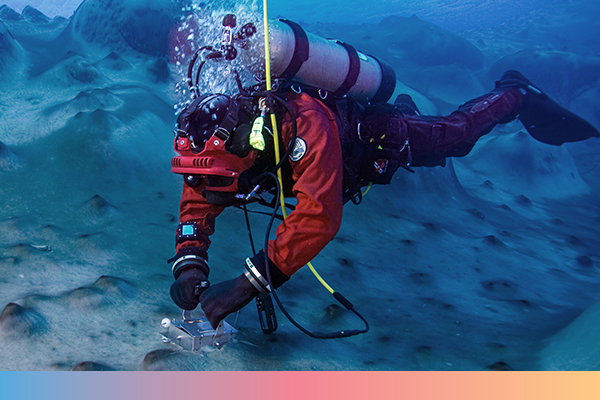
Dale Andersen works gently to avoid damaging fragile bacterial colonies.
Located in the mountains of East Antarctica’s Queen Maud Land, perennially ice-covered Lake Untersee is dammed at its northern end by the Anuchin Glacier. It’s a cold and dry region where sublimation rather than melt is the main mass-loss process for local glaciers and lake ice. There are no meltwater streams that typically recharge Antarctic lakes with water, nutrients, aquatic life, and pH-buffering carbon dioxide. Instead, Untersee is recharged entirely by subaqueous melting of glacial ice and subglacial groundwater with a very tight, icy seal from the atmosphere.
The lake has two sub-basins. The larger northern basin is well-mixed and 170 meters deep. The south basin is separated by a sill at about 50 meters and has a max depth of 100 meters. The water column of the ultra-oligotrophic lake can be super-saturated with oxygen and poor in nutrients and carbon. Scarce resources are tied up in bacterial mats that cover the lake bottom and used by cyanobacteria to build cones, slowly piling up alternating clear and opaque layers 0.2 to 0.8 millimeters thick, like tree rings.
In the southern basin, from about 70 meters below the ice to its maximum depth of 100 meters, the cold lake is anaerobic, and dissolved methane concentrations can reach 21 millimoles per liter. Many people, including Andersen, think that's a lot like Mars used to be.
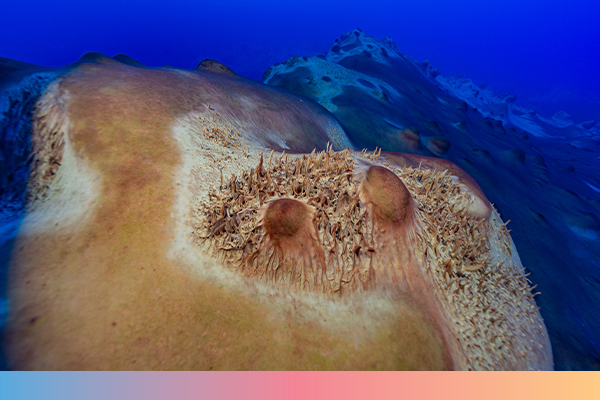
Bacteria built these mats, cones, and pinnacles.
“Mars has probably always been a very cold place," says Andersen. "Even during its warmest times, the early Martian environment may have resembled the McMurdo Dry Valleys or Untersee Oasis. As we carry out investigations in these Antarctic analogs, we think they might provide a glimpse of early Mars. Perhaps microbial ecosystems once existed there as well—not exactly the same as seen in the Antarctic lakes but similar nonetheless. If there was an independent origin of life on Mars, that life was probably quite different. But Martian life may have faced environmental pressures similar to those confronted by microbial communities in Antarctica, leading to similar evolutionary solutions.
"Working with the stromatolitic communities in the lake helps inform the search for evidence of life in paleolacustrine sediments on Mars, and the anaerobic regions of the south basin of Untersee helps us focus on what it will take to search for life in the oceans of Enceladus and Europa, the outer moons of Jupiter and Saturn," he adds.
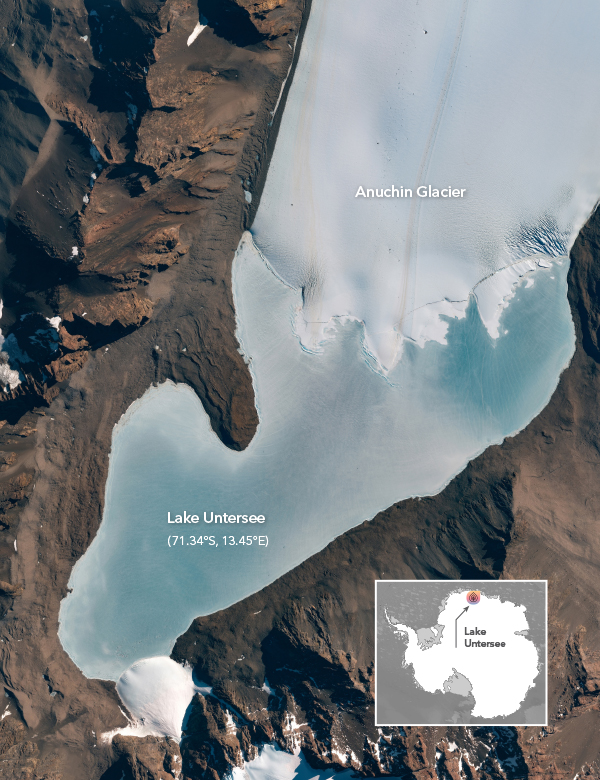
Crammed into an elbow of rock by the Anuchin Glacier, Lake Untersee is 6.5 km long and 2.5 km wide. Its 8.73 km2 (2157-acre) surface is tightly capped by a three-meter-thick sheet of ice.
Deep Study
Andersen works with multi-disciplinary teams at Lake Untersee.
The expeditions are typically a multi-national, multi-generational affair, with experienced scientists from the U.S., Canada, New Zealand, Russia, Japan, and Italy represented over the past few years, along with students learning to operate in the polar environment. Geobiology, meteorology, limnology, hydrology, and more are on the agenda, and the group of about six researchers spend six to eight weeks per year in a furious race against time and the weather to gather data in and around the lake.
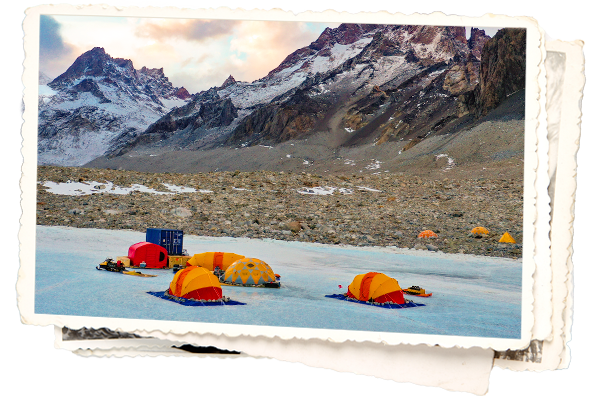
Camping at Lake Untersee is no picnic. All supplies must be dragged six hours from the Russian airbase by snowmobile to reach the site. Knot-tying skills are a must: tents must withstand 100-knot winds.
After flying to Antarctica from Cape Town, South Africa, and landing on the ice runway at Russia's Novolazarevskaya research station, the team must traverse the ice over a day-long snowmobile ride out to the lake.
Then they set up camp, drill a hole through the ice and, using a sealed melting system, start circulating warm water through a cylindrical coil that will steadily melt through the ice to create access to the lake for diving—a process that can take more than 24 hours. Smaller 10-inch diameter holes drilled through the ice are used for lowering instruments and obtaining water samples.
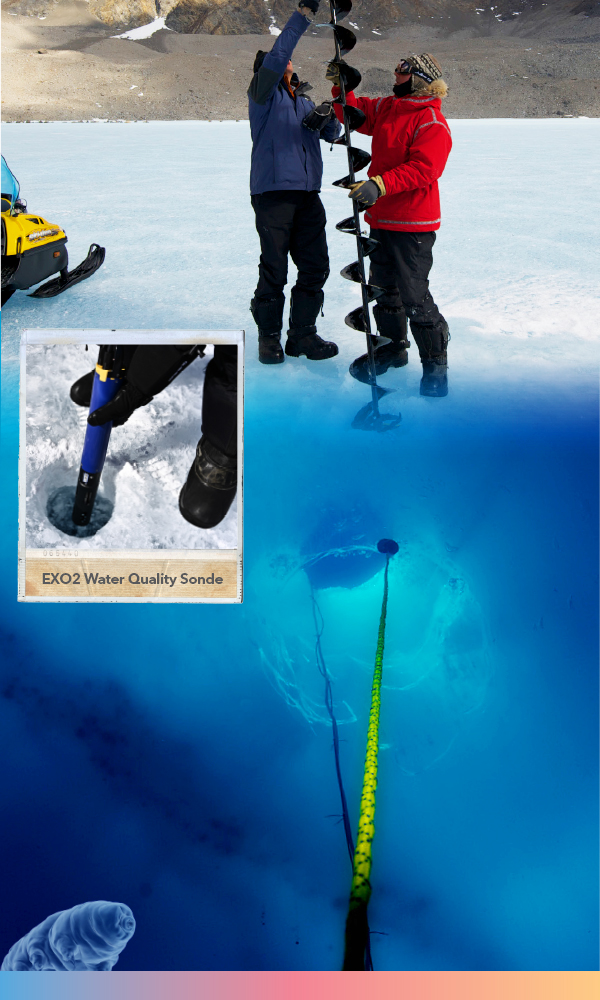
An EXO2 provides water quality and thermocline data.
Andersen is fastidious about collecting water quality measurements throughout the water column. He uses a YSI EXO2 Multiparameter Sonde with smart sensors for turbidity, total algae, pH, oxidation-reduction potential (ORP), fluorescent dissolved organic matter (fDOM), dissolved oxygen (DO), and conductivity.
Slowly lowering the sonde—a meter or even a half-meter at a time—and keeping an eye on the software ensures that he and his colleagues can spot subtle shifts in values as temperatures, oxygen levels, and chemical composition vary.
"In the south basin below 70 meters, one observes very fine stratification while descending through the chemocline," he says. "We want to identify and record measurements within the different horizons so we can then sample or set up experimental assessments of metabolic pathways in areas
of importance.
"It doesn't take us long to set up," Andersen adds. "I usually try to unspool the cable in advance, using only as much as we need, then we just have to lower it down. As soon as the sonde is beneath the ice at five meters, l let it sit undisturbed for a few minutes until the sensors have normalized to ambient conditions and I have stable readings. Then we move slowly downward to profile the water column."
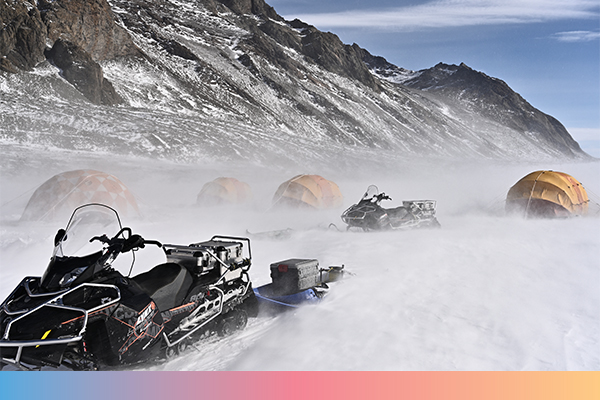
Researchers put their snowmobile skills to the test during the expedition to Lake Untersee.
Not Your Average Water Sampling Run
Every tech and researcher has had a rough, cold day out in the field. But few have to take their measurements hunkered behind a snowmobile to stay out of Antarctic gusts that can blast at 60, 70, even 100 knots.
"It can be a fire hose of wind just blowing down from the glacier above," says Dale Andersen at the Carl Sagan Center with the SETI Institute, describing his research missions at Lake Untersee in Antarctica. "You can have a reasonably constant wind, but then you'll get these sharp gusts that just pound us, like cannons going off. That's probably our biggest challenge. So sometimes we have to crouch down behind the snowmobiles while we're collecting measurements."
Diving beneath three meters of ice doesn't faze Andersen, who layers Merino wool undergarments and socks beneath a diver's thermal garment and climbs into a dry suit—in all, a pretty warm outfit, other than for the gloved hands.
A 300-foot tether serves as a communications cable and lifeline for under-ice divers, who swim gently to avoid damaging fragile bacterial mats and structures with turbulence from their flippers. On top of the ice, scientists monitor the diver and take notes of their observations.
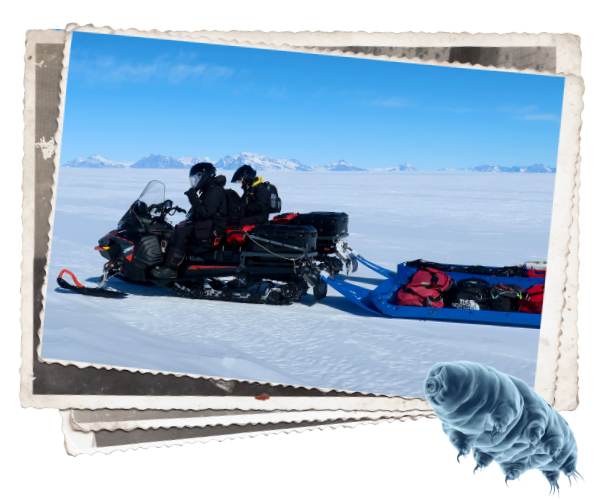
Though the water at the entry hole is prone to freezing and exiting the water creates a cacophony like a picture window shattering, life under water is actually often warmer and more comfortable than on the windblown surface, Andersen notes.
"Usually, the hardest part is not for the diver, it's for the people on the surface who have to stand around and wonder what the diver's doing," he says.
Out of the water, the diver's challenge can be having the suit freeze solid during the snowmobile ride back to camp. Just straightening up to get undressed could take a while of sitting by the propane heater in the warming tent, Andersen notes.
Dam Burst
Under the ice, Lake Untersee is generally a very calm environment, with extremely slow circulation of water across the lake. Andersen says a particle would take about a month to travel the lake's 6.5-kilometer length. However, there is occasional drama.
Examining satellite altimetry data, Andersen and his colleagues noted a sudden two-meter rise in Lake Untersee's water level in early 2019 and a drop in the level of Lake Obersee, about six kilometers away. Satellite imagery and a camera at the team's meteorological station also recorded a sudden release of water bursting onto the ice surface at Lake Untersee at the same time. It seems an ice dam had burst at Lake Obersee, releasing an estimated 17.5 million cubic meters of water into Lake Untersee over a 3-week period, a glacial lake outburst flood rarely observed in Antarctica.
Based on subsequent observations and measurements, Andersen says it was likely a 300-to-500-year event—and a remarkable opportunity to study the effects of such a flood on a lake where scientists had collected decades' worth of stable baseline data.
Upon returning to Lake Untersee in November 2019, Andersen immediately deployed a multiparameter sonde to measure the lake's water quality. Between visits, the lake's pH dropped from 10.5 to 9.5, specific conductivity fell from 505-520 to 485 µS/cm-1, dissolved oxygen decreased from 150% to 128%, and total inorganic carbon rose significantly.
"We witnessed a major shift in water chemistry as a result of this flooding event," Andersen notes. "These measurements are important and the kind that will help us understand the impacts that global warming will have on Untersee’s microbial ecosystem over the coming years; so measuring shifts in pH, temperature, turbidity, and the like with repeatable accuracy is paramount."
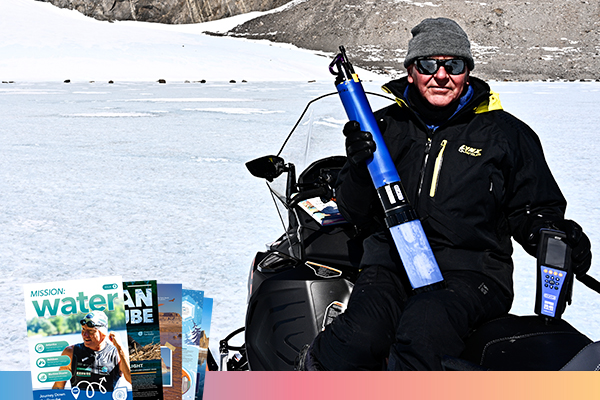
Go Deep — Join Dale Andersen and his colleagues on a dive beneath the ice of Lake Untersee and see the lake's unique stromatolites at: bit.ly/UnderseeVideo
Nobody knows what caused Lake Obersee to release its floodwaters into Untersee. But the glacial lake outburst flood could also be a hint of those possible changes that could be prompted by climate change.
"If we just increase the mean annual temperature around Untersee Oasis—which includes Lake Obersee, too—by a degree, followed by an increase in the number of degree days above freezing, we could start changing Untersee’s ecosystem dramatically because liquid water would begin flowing off the sides of the glacier, bringing that meltwater directly into the lake," Andersen says.
"We would expect to see moats form around the margins of the lake and meltwater collecting on the ice-cover. That would increase the amount of sedimentation coming in. The pH of the water-column would shift, dropping to circum-neutral, the carbonates and silicates that are present would probably precipitate out, and turbidity levels would likely go up. We have no idea how this might affect the structure and function of the biological community, but the habitat would certainly see large changes.
"Coming back to tools like the EXO2, being able to monitor those environmental variables is going to be a key player in what we do," he adds.
As Andersen describes the world he is exploring under the Antarctic ice, NASA's Perseverance rover is streaming gigabytes of images from the surface of Mars. Perseverance is 141.6 million miles from Lake Untersee, and its strange stromatolites are separated from most life on Earth by about 3 billion years. Yet those two worlds may well meet as scientists pore over photos from both realms, eager to understand the origins of life on our planet and searching for hints of life on others.
